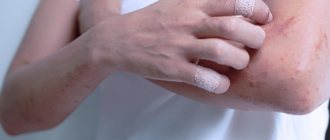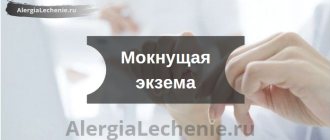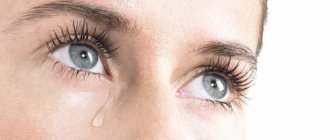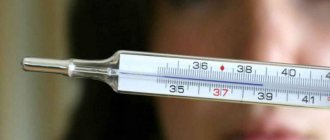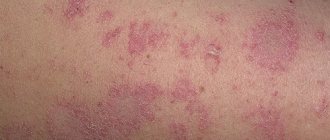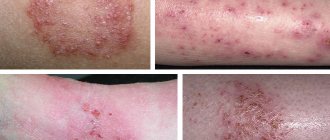Microbial eczema (bacterial) is diagnosed in 30% of cases. It occurs on previously damaged epithelial tissues and is not considered an independent pathology. The disease most often appears at the site of infected wounds, scratches, various ulcers, as well as against the background of another disease (for example, varicose veins).
Causes of manifestation
The disease is provoked by varicose veins, lymphostasis, mycosis and allergic reactions.
Its development is influenced by external factors:
- hereditary predisposition;
- disruption of the endocrine system;
- diseases of the gastrointestinal tract, liver, kidneys;
- weakened immunity.
| 1 group of pathogens | 2nd group of pathogens | 3 group of pathogens |
| Staphylococci, streptococci | Fungi of the genus Candida | Protea, Klebsiella, Neisseria |
A common cause is non-healing incisions after surgery.
Risk subgroups
The development of microbial eczema is not affected by a person’s gender or age. However, there is a group of people most susceptible to this disease:
- Patients prone to diathesis.
- People with reduced stress tolerance.
- Patients suffering from dysfunction of the endocrine system, specifically the adrenal glands, pituitary gland or thyroid gland.
- Persons who do not comply with the rules of personal hygiene.
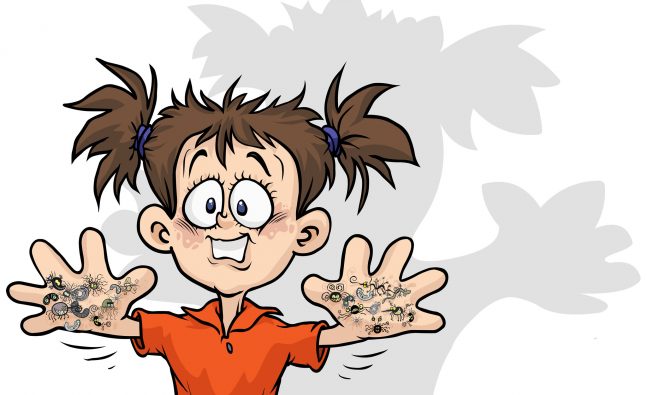
These factors cannot be called fundamental in the course of the disease, but they can provoke it and create conditions for a rapid inflammatory process.
Prevention measures
Chronic eczema may not develop if certain safety measures are followed.
Measures:
- Carefully observe hygiene rules,
- Treat all diseases in a timely manner,
- Lead a healthy lifestyle,
- Monitor your nutrition, follow the prescribed diet,
- Take vitamin complexes,
- Wear quality clothes and shoes,
- Treat the acute stage only as prescribed by a specialist, do not engage in self-therapy.
Chronic eczema is an unpleasant disease that causes a lot of trouble for the patient. It is difficult to cure, but if you follow all the doctor’s prescriptions, it is possible to achieve stable remission of the disease.
Symptoms and signs of microbial eczema
There are several types of microbial eczema, but they have common symptoms:
- redness;
- severe itching of the skin;
- burning;
- sleep disturbance;
- peeling of skin;
- the appearance of a wet or dry rash resembling psoriasis;
- separation of pus. The wound remains wet for a long time and heals slowly. Eczematous boundaries have a clear contour. With successful elimination of symptoms and inflammation, the skin remains deformed and darkened (develops on previously damaged areas: abrasions, cuts, purulent lesions). In the center of the affected area there are white formations filled with serous fluid.
Such manifestations require immediate medical attention.
Types of eczema and their symptoms
- Plaque - sizes vary from 3 to 5 cm. There is constant redness of the epithelium, swelling and a weeping surface. The appearance of a purulent crust is characteristic. It only spreads on the hands.
- Varicose veins - accompanied by dilation of veins in the affected area. Itching is moderate. It is possible that ulcers may form near the vessels.
- Sycosiform - inflammation of the hair follicles. Characterized by wetness. Localized in the scalp, armpits, and pubic area. The causative agent is Staphylococcus aureus.
- Nipple - manifests itself in women at the end of lactation, and in persons with scabies. The surrounding skin becomes covered with small cracks, itches and turns red. In addition, severe pain appears.
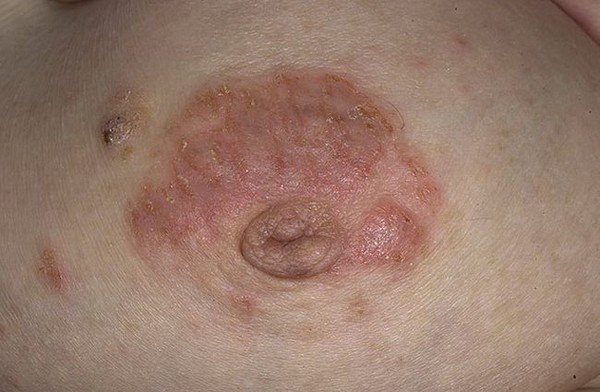
All these signs are typical for adults and children. The chronic form is distinguished by a large area of damage and is called true.
Forms of the disease
Based on the type of predominant pathological processes, weeping and dry forms of the disease are distinguished; in the latter case, depending on the location of the lesions, the processes of keratinization or lichenification may predominate.
There are several types of chronic eczema, the appearance of which is associated with the action of various factors:
- atopic (idiopathic form), which can occur in children and has a severe course with widespread skin lesions;
- allergic eczema, directly related to the effects of allergens on the skin or their entry into the body;
- microbial form and its variety – nummular (coin-shaped) eczema, in which inflammation is supported by a bacterial infection;
- occupational eczema caused by regular contact with chemicals in the workplace;
- dyshidrotic eczema, characterized by large-plate peeling and occurring on the soles and palms;
- tylotic or callous form, which also occurs only on the feet and palms and is characterized by increased keratinization of the affected skin with severe itching;
- varicose form of the disease, appearing at the site of trophic changes in the skin in varicose veins of the lower extremities;
- sycosiform eczema, which develops with multiple inflammation of the hair follicles (sycosis).
Sometimes seborrheic dermatitis is also classified as eczema if it is accompanied by weeping and the formation of serous crusts. But this is not entirely correct; rather, we are talking about eczema-like changes. A number of authors exclude microbial eczema from the classification, also classifying it as dermatitis.
A separate category is the childhood form of the disease, often called diathesis. Mostly redness, weeping and crusting appear on the child’s face, which is usually associated with hypersensitivity to various foods. Childhood eczema may resolve or develop into atopic dermatitis.
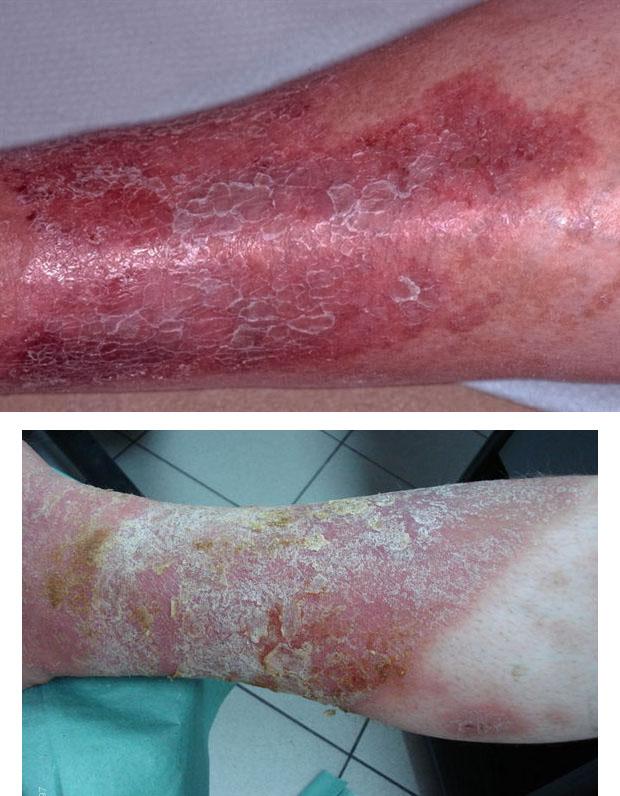
Differential diagnosis
To correctly diagnose the disease, a comprehensive examination is required. The doctor should do the following:
- Study your medical history.
- Conduct an external examination of all parts of the body where eczema may be localized (arms, legs, scalp, pubis, armpits).
- Interview the patient about when the first exacerbation occurred, how long it lasted, and after what period of time the relapse occurred.
Sometimes an external examination does not guarantee one hundred percent accuracy, so doctors turn to specialists in the laboratory. The patient should undergo tests:
- culture of secreted pus or scraping from the affected area of skin;
- scraping for pathogenic fungus;
- general and chemical-biological blood test.
These research methods allow not only to accurately diagnose the disease, but also to exclude the presence of other diseases: psoriasis, dermatitis, cutaneous reticulosis, familial pemphigus.
Symptoms
The general symptoms of the disease are similar to those of any other types of eczema and are as follows:
- swelling of the affected area;
- redness;
- small blistering rash;
- itching, burning;
- increase in temperature.
In the photo below you can clearly see the signs of post-traumatic eczema, manifested by swelling of the skin and rash.
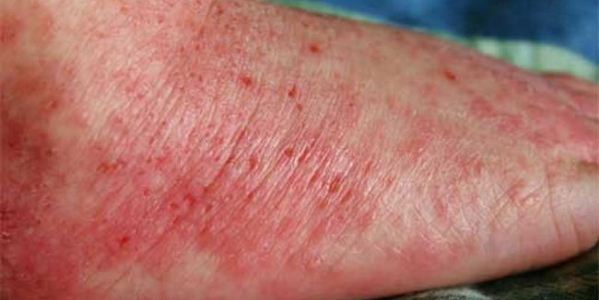
It should be noted that the pathology has several stages, each of which is characterized by certain symptoms.
- Erythema. The borders of the wound begin to turn red, “burn”, and itch very much. Damage occurs to the superficial layers of the skin.
- Papular. The area of inflammation is covered with small pinkish dense nodules.
- Vesicular. The former formations are replaced by bubbles filled with liquid, which open and burst over time.
- Pustular. Pus forms inside the vesicles as a result of the activity of microorganisms, and the vesicles acquire a light color. After some time, the pustules also burst.
- Getting wet. The place of the rashes is occupied by eroded, constantly weeping areas of the skin. In the case of proper care and the absence of unfavorable circumstances, the inflammation gradually disappears.
- Crust. Due to exposure to air, the contents of the bubbles dry out, leaving behind white, yellowish or brown crusts.
- Scaly. When the surface layers of the skin dry out, small scales are formed that are prone to damage. Because of this, the weeping stage will be repeated and the eczema will become chronic. Over time, the wound may never go away completely, leaving behind roughened skin with unsightly pigment spots.
Treatment
Therapy should be aimed at eliminating the infectious focus and the underlying disease. The plan is drawn up based on the etiological factor. Treatment should be comprehensive, using not only local drugs, but also intravenous ones.
Drug treatment
Drug therapy involves local or course treatment. For pyoderma eczema (staphylococcus, streptococcus), medication is indicated. It applies:
- antihistamines;
- complex vitamins (mainly group B);
- sedatives;
- antibacterial and antifungal ointments for topical use;
- antiseptics;
- astringents.
They treat fungal-affected areas and treat ulcers and sycosis.
Physiotherapy
- Magnetic therapy.
- Ozone therapy.
- Laser therapy.
- Ultraviolet irradiation.
- Ultrahigh frequency therapy.

Laser therapy
In addition to eliminating the underlying problem, physical therapy can help get rid of traces of the rash.
It is important to use a gentle diet that excludes foods that cause allergies (if eczema has become true).
Traditional medicine recipes
Treatment with folk remedies includes local application of herbal lotions and is used only as an additional therapy to the main treatment.
Effective lotions from plant decoctions:
- calendula;
- celandine;
- series;
- nettle;
- St. John's wort;
- yarrow;
- birch.
Wetting with infusion of pine needles and cones: add 1 liter of water per 100 grams, leave for about 15 minutes and apply to eczema.
Elderberry leaves have a pronounced antiseptic effect. They need to be mashed so that they release juice, applied to the skin and wrapped in cling film.

Elder
Inflammation can also be favorably influenced from the inside. To do this, you need to make tea from dandelion root. The brewing process lasts up to 12 hours, drink several times a day. This drink improves the functioning of the immune system and helps cope with the bacterial component in the skin.
Drug therapy
Treatment must be comprehensive. When choosing appropriate methods of therapy, the form of the disease, the degree of its progression, as well as the individual characteristics of the patient’s body are taken into account.
For therapy, medications are used in the following forms of release:
- products for internal use (tablets, syrups);
- external medications (ointment, cream, gel);
- injection solutions.
For chronic eczema, the following groups of drugs are used for treatment:
- Antihistamines. Used for allergic diseases. The most effective are Tavegil, Suprastin, Claritin, Erius.
- Immunomodulators. Timalin and Splenin are usually prescribed.
- Calming agents. Used in the presence of nervous agitation. Among such drugs are Persen, Notta, Novo-Passit, Glitsed, extracts of valerian, motherwort.
- Vitamin and mineral complexes. It is recommended that the patient take vitamins A, C, B, and folic acid.
In some cases, during an exacerbation, the patient is prescribed intravenous injections of Calcium gluconate, Sodium thiosulfate, and Calcium chloride.
In case of pathology, medications for external use must be prescribed.
These include creams, ointments and gels of the following groups:
- Hormonal. Relieves inflammation, heals wounds and restores skin. Popular ones are Advantan, Elokom or Lokoid.
- Non-hormonal. Reduce itching and inflammation. Among the effective drugs in this group: Protopic, Pimecrolimus.
- Antifungal and antibacterial. Pimafucort is often used for fungal infections. If a secondary bacterial infection occurs, Triderm is used.
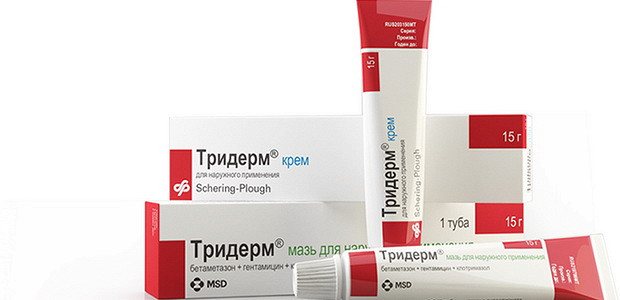
Medications should only be prescribed by a qualified doctor after diagnosing the disease.
